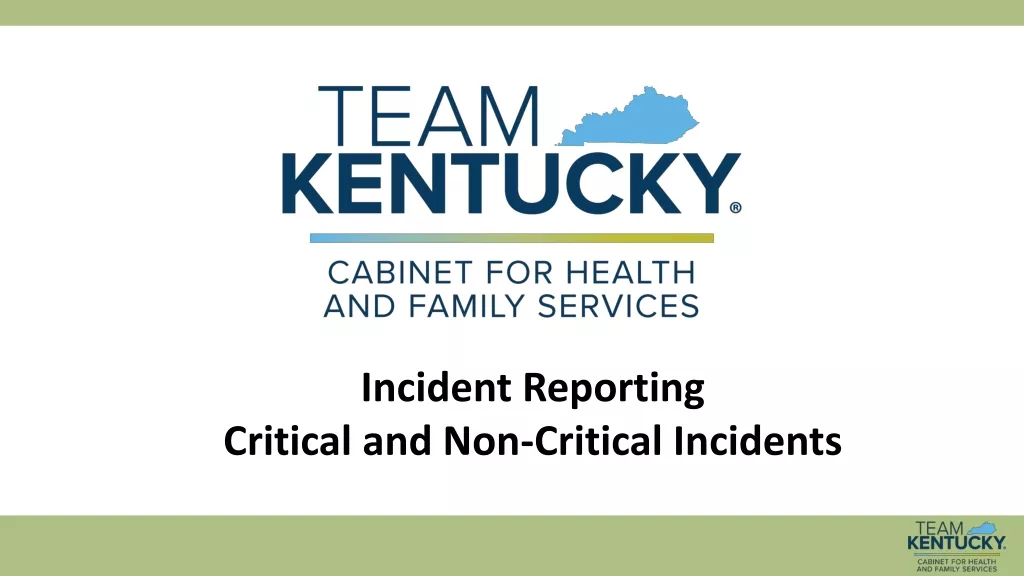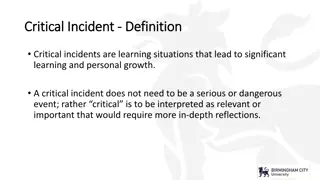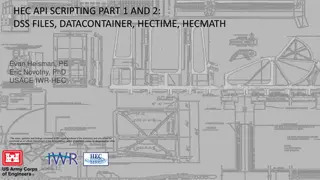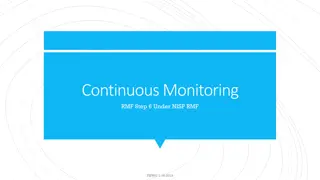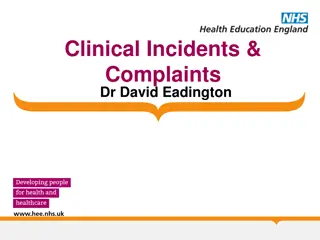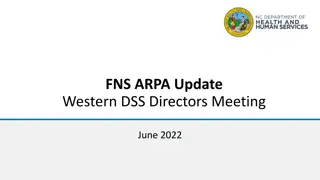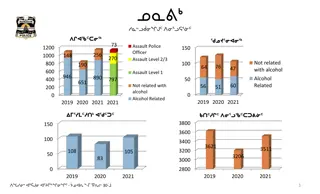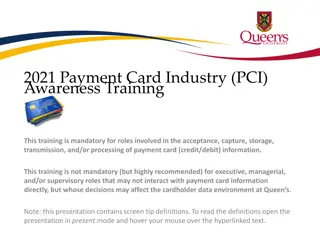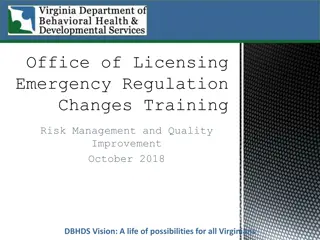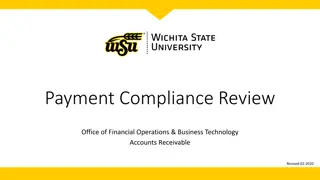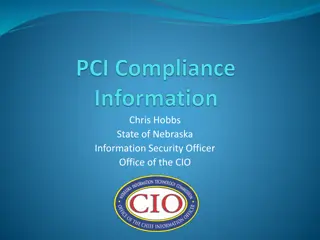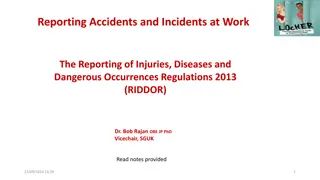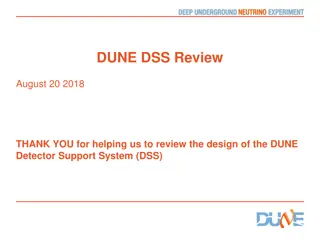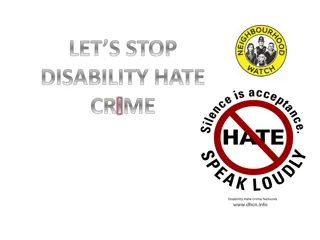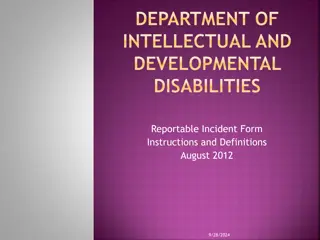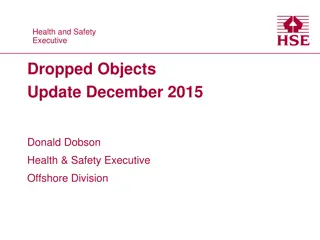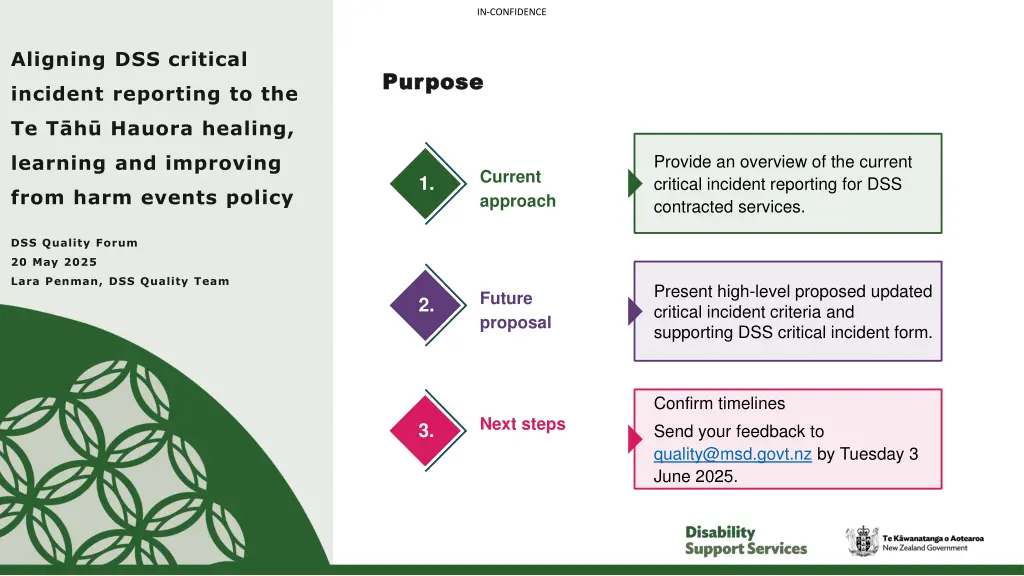
Aligning Critical Incident Reporting for DSS Contracted Services with Te T.H. Hauora
Provide an overview of the current critical incident reporting framework for Disability Support Services (DSS) contracted providers. The approach includes mandatory reporting within 24 hours for events involving severe harm, with proposed updates to align with Te T.H. Hauora for enhanced learning and improvement. Changes include raising severity thresholds, updating incident categories, and supporting contract providers to report harm events effectively. Feedback deadline for the proposed changes is Tuesday, 3 June 2025.
Download Presentation

Please find below an Image/Link to download the presentation.
The content on the website is provided AS IS for your information and personal use only. It may not be sold, licensed, or shared on other websites without obtaining consent from the author. If you encounter any issues during the download, it is possible that the publisher has removed the file from their server.
You are allowed to download the files provided on this website for personal or commercial use, subject to the condition that they are used lawfully. All files are the property of their respective owners.
The content on the website is provided AS IS for your information and personal use only. It may not be sold, licensed, or shared on other websites without obtaining consent from the author.
E N D
Presentation Transcript
IN-CONFIDENCE Aligning DSS critical Purpose Purpose incident reporting to the Te T h Hauora healing, learning and improving Provide an overview of the current critical incident reporting for DSS contracted services. Current approach 1. from harm events policy DSS Quality Forum 20 May 2025 Lara Penman, DSS Quality Team Present high-level proposed updated critical incident criteria and supporting DSS critical incident form. Future proposal 2. Confirm timelines Send your feedback to quality@msd.govt.nz by Tuesday 3 June 2025. Next steps 3.
IN-CONFIDENCE Current approach 1. All DSS contracted providers must report critical incidents within 24 hours Critical incident: an event where there is severe or major harm to the person. DSS, as part of our stewardship and commissioning functions, checks that providers are delivering safe and quality supports, and are managing incidents well. Approximately 75% of reported critical incidents come from community residential services. We want to encourage a strong reporting culture to inform ongoing service improvement. For more information see Reporting of critical incidents and deaths | Disability Support Services. IN-CONFIDENCE
IN-CONFIDENCE Current approach 1. In the last year DSS has received an average of 282 critical incident reports each month Table 1: Reported critical incidents by category (Jan-Mar 2025 quarter) Percentage of total Incident Category (current categories) Number reported 186 23% Hospitalisation of a disabled person 159 141 20% 18% Abuse or assault by a disabled person to a non-disabled person Police or emergency services involved 138 17% Abuse or assault of a disabled person 90 11% Restraint or seclusion 27 3% Serious injury of a disabled person 63 8% Other 795 100% Total IN-CONFIDENCE
IN-CONFIDENCE Future proposal 2. DSS is updating the DSS critical incident categories and severity threshold to align with Te T h Hauora DSS providers who are contractually or legally required to comply with Ng Paerewa are also required to report harm events to Te T h Hauora Health Quality and Safety Commission (Te T h Hauora). We are working with Te T h Hauora and providers to align the reporting processes. This project will: improve targeting of the most high-risk incidents align the process for providers support learning and improvement for disability support services. IN-CONFIDENCE
IN-CONFIDENCE Future proposal 2. DSS is proposing four changes to go live from 1 July 2025 1. To raise the threshold of what we classify as critical so it aligns with Te T h Hauora severity assessment codes (SAC) 2. To update the DSS critical incident categories 3. To update the DSS critical incident reporting form 4. To support DSS contracted providers to report SAC 1 and SAC 2 harm events to Te T h Hauora. IN-CONFIDENCE
IN-CONFIDENCE Future proposal 2. Raising the threshold of what we classify as critical Severe, life-threatening or major harm DSS Critical incidents SAC 1 or 2 Moderate or minor harm Non- critical incidents SAC 3 or 4 IN-CONFIDENCE
IN-CONFIDENCE Future proposal 2. Criteria for DSS critical incidents and Severity Assessment Code (SAC) Definition An event where there is severe, life- threatening or major harm to the person. DSS Incident Severity criteria Severe or life-threatening harm: Te T h Hauora SAC criteria SAC 1 Severe or life-threatening harm: Critical incident Death or harm causing severe loss of function and/or requiring lifesaving intervention. Includes, but is not limited to, incidents that meet the SAC 1 criteria. Death or harm causing severe loss of function and/or requiring lifesaving intervention. Where the harm event was the result of a departure from the planned provision of support, differs from the immediate expected outcome of care or was not related to the natural course of illness or treatment. (DSS always report critical incidents) Major harm: Harm causing major loss of function, serious injury and/or requiring significant intervention. Includes, but is not limited to, incidents that meet the SAC 2 criteria. SAC 2 Major harm: Harm causing major loss of function, serious injury and/or requiring significant intervention. Where the harm event was the result of a departure from the planned provision of support, differs from the immediate expected outcome of care or was not related to the natural course of illness or treatment. IN-CONFIDENCE
IN-CONFIDENCE Future proposal 2. Criteria for DSS critical incidents and Severity Assessment Code (SAC) Definition An event where there is moderate or minor harm to the person. DSS Incident Severity criteria Moderate harm: Te T h Hauora SAC criteria SAC 3 Moderate harm: Non- critical incident Harm causing short-term loss of function, injury and /or requiring moderate intervention. Includes, but is not limited to, incidents that meet the SAC 3 criteria. Harm causing short-term loss of function, injury and /or requiring moderate intervention. Where the harm event was the result of a departure from the planned provision of support, differs from the immediate expected outcome of care or was not related to the natural course of illness or treatment. Minor harm: Harm causing no loss of function and requiring minimal intervention. Includes, but is not limited to, incidents that meet the SAC 4 criteria. SAC 4 Minor harm: Harm causing no loss of function and requiring minimal intervention. Where the harm event was the result of a departure from the planned provision of support, differs from the immediate expected outcome of care or was not related to the natural course of illness or treatment. IN-CONFIDENCE
IN-CONFIDENCE Future proposal 2. What do providers need to do? Incident type Critical incidents Provider action for DSS Additional provider action for Te T h Hauora Determine if incident meets SAC 1 or 2 criteria, and if so, notify Te T h Hauora within 30 working days (Part A) with provisional SAC 1 or SAC 2 rating. Always report to DSS within 24 hours. Manage, review and learn from the incident. Review and learn from the incident. Complete (Part B) report requirement to Te T h Hauora within 120 working days. Non-critical incidents Reporting not required. Reporting of SAC 3 or SAC 4 not required. Manage, review and learn from the incident. Review and learn from the incident. IN-CONFIDENCE
IN-CONFIDENCE Future proposal 2. Proposed updated DSS critical incidents categories 1. Death of a disabled person (as a result of an incident) 2. Serious medical event or serious injury of a disabled person 3. Self-harm by a disabled person 4. Abuse or assault of a disabled person by a disabled person 5. Abuse or assault of a disabled person by a non-disabled person 6. Abuse or assault of a non-disabled person by a disabled person 7. Restraint or seclusion 8. Unauthorised leave of a disabled person under a court order 9. Disabled person missing 10.Incident related to police involvement, external investigation or media IN-CONFIDENCE
IN-CONFIDENCE Future proposal 2. Examples of DSS critical incidents DSS incident category Severe / life- threatening harm Major harm Moderate harm Minor harm Serious medical event or serious injury of a disabled person The disabled person requires life-saving intervention or will likely have a severe long-term loss of function from: - a fall - choking - pressure injury - accident - medication or treatment error - etc The disabled person has a major medical event or injury and is admitted to hospital from: - a fall causing fractured bone, head injury - serious cut or burn requiring a skin graft - choking or recurrent aspiration pneumonia - medicine or treatment plan error - Stage 3 or 4 pressure injury. - etc The disabled person has a moderate medical event or injury and has a moderate medical intervention (unplanned visit to GP, ED or community health services; planned admission to hospital; admission to hospital for observation only). A minor medical event or injury (or near miss) that results in: - no loss of function, or - requiring little intervention / first aid only. IN-CONFIDENCE
IN-CONFIDENCE Future proposal 2. Updated DSS critical incident form for use from 1 July 2025 Minor changes only. Key changes to the form: 1. Updated incident categories 2. New: choose a severity level: severe, life-threatening harm major harm 3. New: boxes to indicate notification to next of kin, peer worker, or safeguarding organisation. 4. Rearranged to fit and flow better 5. Clearer instructions. DSS will publish critical incident reporting guidance on the website. IN-CONFIDENCE
IN-CONFIDENCE Next Steps 3. Action Due by Send your feedback to quality@msd.govt.nz. 3 June 2025 DSS to publish the updated critical incident guidance and reporting form on the DSS website 20 June 2025 Go live : Providers use the new reporting forms from this date. DSS will accept new forms and old forms during the first 3 months transition period. 1 July 2025 DSS contracted providers have 3 months to transition their incident processes to the new critical incident guidance, process, and reporting form 30 September 2025 DSS funded providers must use new critical incident forms from this date. 1 October 2025 IN-CONFIDENCE


